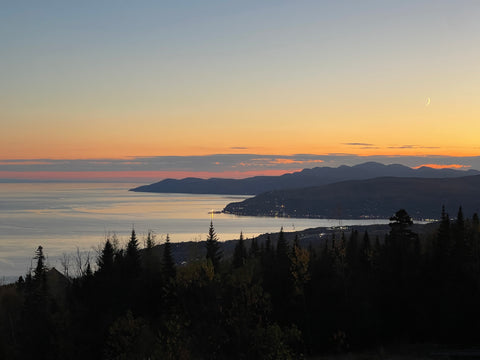FREE SHIPPING: All orders CAD$80 / USD$60 or higher
Discovering Charlevoix

The Charlevoix region of Quebec, a UNESCO Biosphere Preserve, offers a unique sense of balance between humanity and untouched nature, and serves as the primary inspiration for our Sans Savon products.
Despite years of exploring Canada on family vacations, Erica and I had never heard of Charlevoix prior to a chance discovery. We saw a real estate article in the New York Times and six months later found ourselves staring incredulously at the breadth of the mighty St. Lawrence from the porch of what is now our home. A summer colony for patrician American families over a century ago, its geographic remoteness and northern climate seem to have cloaked Charlevoix in obscurity even to most Quebecois ever since. A place where the passage of time is measured in tides, weather systems and seasons – the pulse of the Earth – anyone looking out at our porch view is at once confronted with the power of nature and the insignificance of the self.

Charlevoix’s unique diversity of geographic features originates from an extraterrestrial incursion. 450 million years ago a massive asteroid struck right in the center of Charlevoix, flattening what were then mountains more massive than the Himalayas and creating a crater that filled in over millennia with nutrient rich soil. Today, half of the ancient crater is covered by the St. Lawrence and the remaining semicircle of sporadic farmland is still hemmed in by mountains covered by boreal forest. The combination and proximity of these three features – water, farm and forest – make Charlevoix emblematic of the balance between humanity and nature that feels lost to time and served as our inspiration for Sans Savon.

Let’s start with the mountains. The Laurentian Mountain range, one of the oldest in the world, is estimated to have averaged 39,000 feet in altitude – 10,000 feet higher than the Himalayas today – when the Canadian Shield buckled to form them over one billion years ago. Charlevoix hosts the most densely mountainous region of the Laurentians, including its tallest peak. While the mountains are now smaller, they remain visually stunning with steep open cliff faces that plunge down to river gorges, glacial valleys or fjords. The boreal forest covering these mountains feels distinctly northern with thick carpets of lush moss, groves of birches and craggy pines, but the vistas are often reminiscent of the Alps and other tightly formed mountains. Water is ever-present, captured in high alpine lakes, overflowing down waterfalls, carving new gorges as gravity pulls it toward the St. Lawrence.

The ever-present St. Lawrence dominates the Charlevoix landscape. Whereas the western coast of North America boasts many coastal mountain ranges, there are almost no eastern mountains other than those in Charlevoix that offer striking views of vast water. This is where the mighty St. Lawrence River becomes the Gulf of St. Lawrence and, at fifteen miles across, makes its presence felt as if it were the ocean. From our house perched 400 meters above the water, we watch as the daily battle between incoming tides and outflowing river plays out in spectacular patterns. Too cold for all but the briefest of plunges, the waters of the St. Lawrence create their own microclimate as weather systems approach, playing out alternatively as brigades of cloud walls or seemingly isolated storm clouds or low-lying dense fog under a cloudless sky. Guests have shared their favorite Charlevoix pastime to be watching the weather.
Culturally, Charlevoix feels like an anachronism – particularly for North America. Deeply French Canadian, as are most Quebecois, the people of Charlevoix seem of the land with many able to trace their lineage back to the mid-1600s when their ancestors left France in search of a better life. It is astonishing how many share the same last names as the crumbling tombstones in the small cemeteries. Unlike so many other rural communities around the world, Charlevoix has retained its population base as young people are able to find rewarding work and chose to remain local. While tourism is important, local businesses – from family farms to independent retail stores to industrial suppliers – thrive and the dominance of national or multinational brands is less than one finds elsewhere. The sense of societal sustainability manifests in the care taken for everything from the cleanliness of streets to the potted flowers proudly displayed on front porches. There is the sense of contentment that comes from people loving where they live.
Whether hiking through the pristine boreal forest, speaking French with a local farmer at the weekly market or watching as the incoming tide forces the river backward, everywhere in Charlevoix one encounters a sense of balance, the give-and-take inherent in all natural cycles. In the absence of excess, everything can thrive. Situated at the boundary between humanity and one of the last swaths of untouched nature on the planet, Charlevoix offers a glimpse of what it could be like if we lived with appreciation, caring and a sense of responsibility for the world that so incredibly sustains us.
As easy as it is to forget, we humans are of nature as well, and our bodies need the same balance to thrive. In caring for ourselves, we need to understand and appreciate the give-and take of our own systems and cycles and avoid our propensity to excess. Rarely is more truly better. With Charlevoix as our inspiration, we created Sans Savon to bring balance to our bodies. A different perspective on cleansing that removes the dirt, grime and germs we want gone and keeps intact the barrier that protects our skin and the microbiome that supports it. And when they flow down the drain, because they are derived from nature, our products biodegrade seamlessly back without a trace. Balance begets balance. Cycles ebb and flow. Sustainability perpetuates.
All because we discovered Charlevoix.




1 comment
Such a lovely, inspiring and nourishing story about the discovery of Charlevoix. So looking forward to the products arriving and a possibly a visit to this part of Canada!